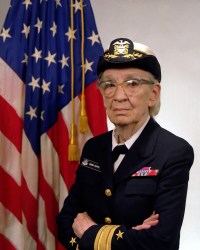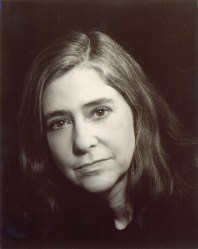Somewhat hidden among athletes, actors, and musicians, three giants of technology have been aptly named as 2016 Presidential Medal of Freedom recipients. Grace Hopper, Margaret Hamilton, and Richard Garwin all made significant contributions to the technology that envelops our lives and embody the quest for knowledge and life-long self learning that we’d like to see in everyone.

Rear Admiral Grace Hopper’s legacy lies with the origins of computer science. She wrote the first compiler. In a time when computers were seen more as calculating machines than easily adaptable frameworks she looked to the future and made it happen. She continued to make huge contributions with lasting effect in developing COBOL, unit testing methods for programmers, and in education. We have long loved her explanation of a nanosecond (and why software engineers shouldn’t waste cycles) and was one of the first to program on the Harvard Mark I which can still be seen in the lobby of the school’s engineering building.
 As Director of Apollo Flight Computer Programming, Margaret Hamilton is the driving force behind the software of Apollo. When the program started, she was Director of Software Engineering at MIT Instrumentation Laboratory. Originally there wasn’t a plan or budget for software in the space program. Hamilton built the program and led the team who wrote the software and turned it into punch cards to be fed into the computer. We enjoyed reading about some of her adventures during the Apollo project, her drive to develop pristine code is palpable. Over the past year we’ve marveled at the rope memory of the Apollo Guidance Computer and delighted when a hardcopy of AGC software showed up at a party. Her legacy at having written the code for the first portable computer — one that happened to land on the moon and return home safely — is incredible.
As Director of Apollo Flight Computer Programming, Margaret Hamilton is the driving force behind the software of Apollo. When the program started, she was Director of Software Engineering at MIT Instrumentation Laboratory. Originally there wasn’t a plan or budget for software in the space program. Hamilton built the program and led the team who wrote the software and turned it into punch cards to be fed into the computer. We enjoyed reading about some of her adventures during the Apollo project, her drive to develop pristine code is palpable. Over the past year we’ve marveled at the rope memory of the Apollo Guidance Computer and delighted when a hardcopy of AGC software showed up at a party. Her legacy at having written the code for the first portable computer — one that happened to land on the moon and return home safely — is incredible.
 Physicist Richard Garwin’s name is most associated with the first hydrogen bomb design. But another part of his work is more likely to have directly touched your life: his research into spin-echo magnetic resonance helped lead to the development of Magnetic Resonance Imaging. MRIs have of course become a fundamental tool in medicine. Garwin studied under Fermi during his doctoral work — you may remember Fermi from our look at the Fermiac analog computer last year.
Physicist Richard Garwin’s name is most associated with the first hydrogen bomb design. But another part of his work is more likely to have directly touched your life: his research into spin-echo magnetic resonance helped lead to the development of Magnetic Resonance Imaging. MRIs have of course become a fundamental tool in medicine. Garwin studied under Fermi during his doctoral work — you may remember Fermi from our look at the Fermiac analog computer last year.
Congratulations to these three recipients, their recognition is incredibly well deserved. We’d love to hear about some of your own technology heroes. Let us know on the tips line so that we may help celebrate their accomplishment and inspire the next generation of giants.
Image Credits:
- Photo of Grace Hopper By James S. Davis — Public Domain
- Photo of Margaret Hamilton By Daphne Weld Nichols — CC-BY-SA 3.0
- Photo of Richard Garwin by A.T. Service — CC-BY-SA 3.0
















All that’s left is for President Obama to pardon Edward Snowden and his work here is done.
Um, no.
well, I suppose depending on your meaning of “here”.
Would be pointless, he would still be murdered by the horror show Trump put in charge if he stepped out of Russia.
Plus Obama is a asshole and he would only do it for that reason.
Which brings me to the comment I was going to make:
Who the hell wants a ‘presidential medal of Freedom’ from a US president? Have they no self-respect?
If you haven’t seen it before, I think Margaret Hamilton has one of the most epic computer scientist photos out there. Here is an image of her next to the hardcopy of the Apollo Guidance Computer source code. She is literally up to her eyeballs in code:

Source: Wikipedia
That’s an amazing photo.
its sad we generally only hear of the exploits of athletics or the mind numbing lives of those in the “entertainment” industry and truely amazing people are left to languish in the shadows – which in all honesty is probly a much more productive place to be.
Grace, Margaret and Richard thankyou for your contribution to our world.
That was indeed a nice visualization of a microsecond.
From another source, the Teach Yourself Programming in Ten Years
“Approximate timing for various operations on a typical PC:
execute typical instruction == 1/1,000,000,000 sec == 1 nanosec
fetch from L1 cache memory == 0.5 nanosec
branch misprediction == 5 nanosec
fetch from L2 cache memory == 7 nanosec
Mutex lock/unlock == 25 nanosec
fetch from main memory == 100 nanosec
send 2K bytes over 1Gbps network == 20,000 nanosec
read 1MB sequentially from memory == 250,000 nanosec
fetch from new disk location (seek) == 8,000,000 nanosec
read 1MB sequentially from disk == 20,000,000 nanosec
send packet US to Europe and back 150 milliseconds == 150,000,000 nanosec “
I remember original Pentium PCs having 60ns RAM. Isn’t modern RAM way faster?
Yes, but not in latency terms (for a random access). On the contrary, the data throughput has increased a lot (when reading blocks of sequential addresses), so the memory appear to be much faster.
.
Anyway, the given numbers from the table are mostly to keep in mind the order of magnitude for various operations.
Hail to the Queen!
I’m wondering the value of making this award to the estimable Ms. Hopper some twenty four years after she passed away. Not that she doesn’t deserve it… Just that it probably would have had a lot more meaning about twenty five years ago.
Isn’t that like asking, “what’s the value of a funeral, the person is already dead”? Shouldn’t they have one while they’re still alive so they’d appreciate it more?
I fail to see why a dead person needs a ‘medal’. Land of the free, home of the award.
To recognize their amazing contribution to society. Humanity needs real heroes. Not these idiotic Kardashians and rappers that seem to grab all the attention.
Besides, promoting the contribution that women have had on our modern society will inspire another young woman who may feel left out because she’s talented….knowing she can change the world can make all the difference.
They obviously don’t.
It’s a gesture of appreciation and an honor to their legacy. How many people outside the tech world would know who Rear Admiral Hopper was prior to this award?